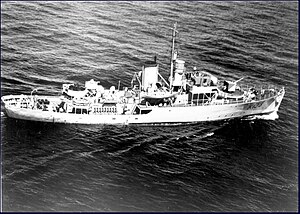 HMCS Quesnel, 10 September 1942, off Vancouver Island
| |
| History | |
|---|---|
| Name | Quesnel |
| Namesake | Quesnel, British Columbia |
| Ordered | 14 February 1940 |
| Builder | Victoria Machinery Depot Co. Ltd., Victoria |
| Laid down | 9 May 1940 |
| Launched | 12 November 1940 |
| Commissioned | 23 May 1941 |
| Decommissioned | 3 July 1945 |
| Identification | Pennant number: K133 |
| Honours and awards | Atlantic 1942-45;[1] Gulf of St. Lawrence 1944[2] |
| Fate | Scrapped 1946. |
| General characteristics | |
| Class and type | Flower-class corvette (original)[3] |
| Displacement | 925 long tons (940 t; 1,036 short tons) |
| Length | 205 ft (62.48 m)o/a |
| Beam | 33 ft (10.06 m) |
| Draught | 11.5 ft (3.51 m) |
| Propulsion |
|
| Speed | 16 knots (29.6 km/h)(18.4mph) |
| Range | 3,500 nautical miles (6,482 km) at 12 knots (22.2 km/h)(13.8mph) |
| Complement | 85 |
| Sensors and processing systems |
|
| Armament |
|
HMCS Quesnel was a Flower-class corvette of the Royal Canadian Navy that took part in convoy escort duties during the Second World War. She primarily saw service in the Battle of the Atlantic. She was named after Quesnel, British Columbia.
- ^ "Battle Honours". Britain's Navy. Retrieved 23 August 2013.
- ^ "Royal Canadian Warships - The Battle of the Gulf of St. Lawrence - Second World War". Veterans Affairs Canada. Archived from the original on 27 September 2013. Retrieved 23 August 2013.
- ^ Lenton, H.T.; Colledge, J.J (1968). British and Dominion Warships of World War II. Doubleday & Company. pp. 201, 212.